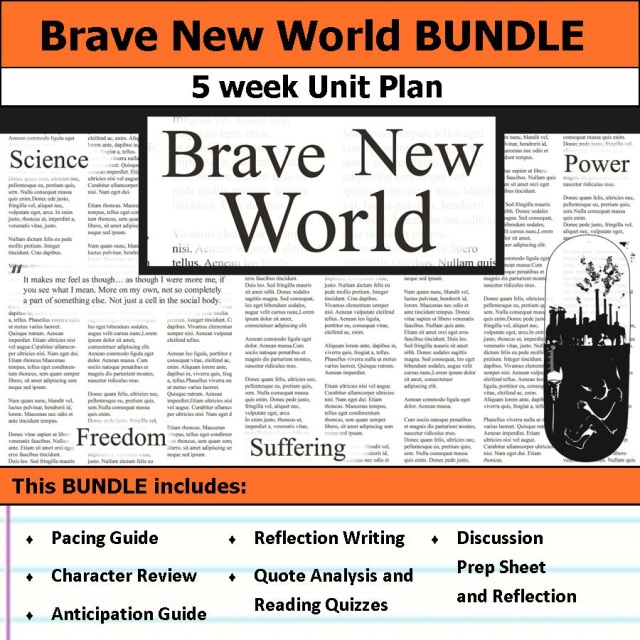

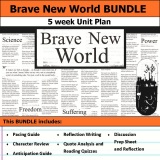
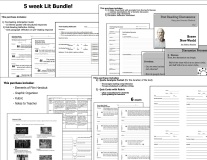
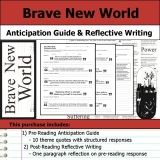
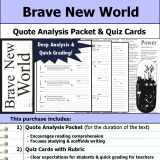
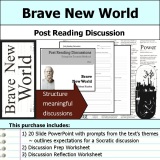
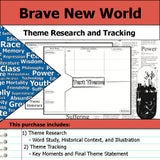
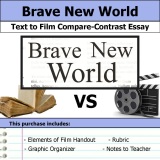
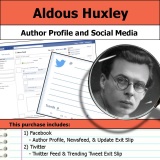
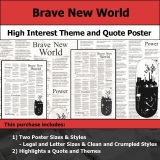
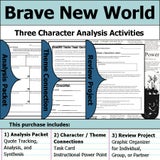
5 weeks of lesson plans. Includes pacing guide, film essay, activities, reading quizzes, and discussions. This bundle has everything you need to get started teaching Brave New World by Aldous Huxley in an engaging way! This unit supports an in-depth analysis of the text. Students will be encouraged to think deeply and write about themes and character development with these activities.
QuantityAnticipation Guide & Reflection:
Get students making "big picture" connections with this anticipation guide and reflective writing. This purchase includes a two page handout with quotes that relate to the text's theme. Students are asked to respond by indicating whether they agree or disagree with the statement and then explaining their opinion. Also included is a teacher's note to explain how to bridge this into an optional discussion, depending on how much time you have. Finally, the writing reflection asks students to relate their opinion to quotes from the text after reading.
These assignments even work well independently, in case you don't have time in your unit plan to use both.
Quote Analysis & Reading Quizzes:
A perfect tool for scaffolding deeper understanding and analysis! This is my go-to tool for helping students process key details and providing regular reading quizzes without drowning myself in grading. The scaffolded approach helps students bridge from reading for plot points to reading for deeper understanding, themes, and life lessons.
Film and Text Essay:
Elements of film handout, essay graphic organizer, rubric, and notes for the teacher. The elements of film handout defines 14 basic elements for students to use as evidence in their essays. The graphic organizer has students pre-plan which scenes their essay will focus on, structures their notes during the film, and plan their thesis statement.
Character Review Project:
Character review project has students work in groups to generate ideas for six of the main characters pertaining to a non-human topic (for example: dishes). Students draw, return to the novel for quotes, and write explanations to justify their ideas. This is a creative project that encourages abstract thinking and evidence-based writing.
Post Reading Discussion - Socratic Method:
Students feel confident with this semi-structured approach to class discussions. This purchase includes a 20 slide PowerPoint that introduces students to the Socratic method for the purpose of discussing a text, a student discussion prep sheet and reflection, and detailed instructions for the teacher on how to facilitate a class discussion. The PowerPoint also includes theme questions to help students expand their perspective on the text, or to extend a discussion that needs to delve a bit deeper.
Author Study - Profile and Social Media:
Engage students in the text using the writing platforms they are most familiar with: facebook and twitter posts. These resources support higher-level thinking skills and a literary analysis based approach to teaching. This resource includes four copy-and-go handouts: author facebook profile, facebook newsfeed, facebook exit tickets, and twitter exit tickets. There is also a note for teachers detailing multiple ways to incorporate these resources into your unit plans, including ways to use them as reading quizzes and assessments.
Theme and Quote Poster:
Highlight key themes and pique students interest with this printable poster. The image can be printed on 8.5x11 and 8.5x14 paper for a bulletin board, student workbook covers, etc. There are two styles: clean and crumpled. You can print this poster on any paper color for endless variety. You can also enlarge the image for a bigger display.
Loving this! Great discussions and activities. Very thorough. Thank you
I'm using this with my AP students and tweaking it a bit to fit them, but the quality is wonderful! Thank you.
Teacher Author's Intent: I use the anticipation guide before reading to get students thinking about the deeper issues at play in the text. It is a flexible activity that can last anywhere from 10 to 45 minutes, depending on how much time you have. With less time, I have students read each quote and respond in writing, basically just follow the instructions independently. With more time, I read each quote to the class and explain it, making sure they understand its meaning before responding. I have also had them discuss the quote with a partner or small group before responding. With even more time (such as an entire class period), I use this as the beginning of a class discussion. Give students about ten minutes to complete the anticipation guide independently. Then, after they have completed it, have them choose one statement that they would like to speak to. I encourage them to choose something they had a strong opinion about and scored either a "1" or a "5." Depending on your class and your time frame, you can have a soap box style discussion where students just explain their opinions from their seat, or you can do a discussion with desks in a circle and ask students to build off of each other's opinions.
The reflection follows the same line of thinking. I've assigned the writing individually as an assignment that may take about twenty minutes, or after a class discussion. Similar to the anticipation guide, I have students revisit those quotes either in small groups or in large groups and discuss them. This time, they need to bring in examples from the text. If you've had students take notes during the text, encourage them to use those to prepare for the discussion. Then, I found that the most thoughtful responses come when I assign students to back up their reflection writing with quotes from the text.
Teacher Author's Intent: I love using these with any major text in my curriculum. It gives students focus for their reading homework, structures their studying, encourages deep thinking, and, not least of all, the quiz cards are a quick grade for me.
I print the Quote Analysis Packet out for each student before we start reading. After day one of reading, I review the first few quotes with the class. I want to make sure they understand what I am looking for in terms of a full credit response on the quiz. I tell students that they should expect a reading quiz the day after reading (whether it be in class or homework). They are responsible for keeping their quote analysis packet up-to-date with the amount of reading that has been assigned. (For example, if chapter one is reading homework, then it is also homework to complete the chapter one quote analysis. Or, if we read chapter one together in class, it is homework to complete the quote analysis.) Depending on how you structure your class, the quote analysis may also work well as small group or partner assignments the day after a reading.
When I give quizzes, students know beforehand that they will only be asked about one of the given quotes on the quiz. I make sure to clarify that they don't get to choose which quote they will write about on the quiz. If I have assigned multiple chapters, then the quiz will still only have one quote, and it can be from any of the assigned chapters. I also like the flexibility of this in case I have multiple hours of the same course. This way, I can use the same style of assessment and easily change the quote from hour to hour without worry of students in later hours having an unfair advantage. Ditto for students who have been absent. Also, I've found it helps to time quizzes. The perfect time limit for me is five minutes. I let students know when there is one minute left, and, at that time, I also remind them to relate their answer to something "deeper than the plot" for full credit.
My grading process for the quiz cards is my favorite part about this style of quiz. Using the rubric on the back of the quiz card, I have a pile for "10," another pile for "7," a third pile for "5," and a final pile for "1." As I read each response, I put it in the proper pile. Then, I write the score on each quiz for a given pile, stack them up, and start on the next hour. It takes me five minutes to grade on class of about 25 quizzes (The same time limit I put on the quizzes, so I can grade the previous hour's quiz in the time it takes my second hour to take the quiz. So nice!)
In terms of grade the quote analysis packets, I have a couple of things that have worked well for me. I stamp each students packet as the questions are due. Students have their packets open to the correct page at the beginning of the hour. I quickly eyeball that the quotes for the assigned reading are complete and stamp at the end of the section. (I have a handful of random stamps from craft stores for this.) At the end of the unit, students hand in their entire packet. To get full credit, each section needs to have a stamp. Then, I generally grade one quote from each section (such as the second quote in each chapter, or the second quote on each page, etc.) This stream-lines grading for me. I am transparent with my students about this from day one of reading, so they know how imperative it is to do a thorough job for a good grade.